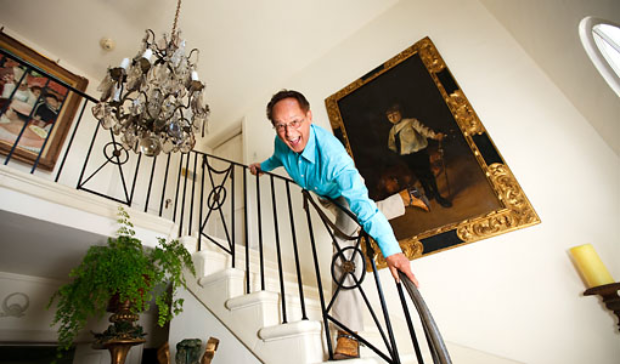Tony Charmoli ’46 always has been a dancer. Decades before “Dancing With the Stars” or “So You Think You Can Dance?” became weekly devotions, the future Broadway choreographer used to cut a rug on Friday nights at the local VFW in Virginia, Minn. Even though his mother didn’t care much for the dance floor, the youngster and his father would spend the night doing the Lindy, jitterbug and any new dance step that migrated from the big cities up to the Iron Range.
It should come as no surprise that Charmoli’s journey – from the Range to St. Thomas to the bright lights of Broadway – reads like a movie script. He has lived and worked in Hollywood for more than 50 years.
As a student at Virginia Junior College in 1941, Charmoli won the U.S. Speech Championship, which caught the attention of St. Thomas’ president, Father Vincent Flynn.
Flynn was looking for someone to lead the college’s debate program and offered Charmoli a scholarship. But Flynn wasn’t alone in his pursuit of the gifted student. Charmoli also received an offer from the University of Kentucky, where one of his older brothers coached football. Kentucky wanted Charmoli to teach dexterity and movement to the football team and offered him a one-year scholarship. But Charmoli turned it down.
“My brother reacted by calling our mother,” Charmoli recalls. “He said, ‘Tony’s not coming down here! His own brother makes the offer, and he’s going to St. Thomas?’
“My mother told him the decision was up to me. I needed two years to complete my degree, and that’s what St. Thomas offered – a two-year scholarship with a stipend to help coach the debate team. In those times it was about the money … well, it’s always about the money. But I’m glad I made the decision I did.”
The scholarship to St. Thomas was essential for Charmoli to reach his goals. “I had to have a degree,” he said. “While I always knew I wanted to dance and be on Broadway, I was equally aware that a college degree would be something that would only enhance what I wanted to do.”
Charmoli turned his attention to what was described as a “somewhat lackluster debate team.” He urged the young men to refrain from simply repeating statistics.
“‘You need passion,’ I told them. ‘You have to convince me that you believe in what you are arguing.’” The team warmed to his advice.
Charmoli recalls a day when the professor came into the classroom and found the students arguing a fine point. They were so intensely involved in the debate that several of them had pulled out cigarettes and began smoking. The teacher scolded, “What is this? Smoking during class?”
Charmoli quickly pointed out, “Look what’s happening. They’re finally getting it!” During his first year at St. Thomas, Charmoli continued his interest in dance by joining the Gertrude Lippincott Dance Company in Minneapolis. “It was a mixed company of black and white dancers,” he recalls. “We were ahead of our time.”
In a passing conversation with Flynn, Charmoli mentioned his dance lessons. When asked how he was keeping up with his studies, Charmoli told him that he was able to squeeze in some schoolwork on the bus ride to and from the studio on Lake Street. Flynn, concerned about Charmoli’s busy schedule, offered to drive him to the studio, watch the lesson and drive him back to campus for some quality study time.
As with many students at the time, Charmoli’s education was interrupted by a call to serve in World War II. He had completed his first year at St. Thomas when he enlisted in the Air Force. In 1943, Charmoli was stationed in Central America as an operations manager. Showing signs of his future career in choreography and directing, he was responsible for coordinating all flights as they arrived and departed from the airbase near Panama City.
When Charmoli returned to St. Thomas in the fall of 1945 to complete his degree, he asked if he could graduate at the end of the semester. He still needed 19 credits and the administration questioned whether it could be done. Charmoli not only finished in one semester, he did so with honors, on time and under budget.
“Not bad for a boy from the Range,” Charmoli quips.
In his last term at St. Thomas, the debate team took top honors in national competition. He thought his work on campus was complete, but at graduation Charmoli was approached by Flynn and Father Edward Klein, English Department chairman. They asked him to teach on campus.
Charmoli turned them down.
“I had to go to New York,” he remembers telling the pair. “I had to do theater on Broadway. That was always my goal. And if I didn’t do Broadway, I wouldn’t feel fulfilled.”
Charmoli left to pursue his dreams, but Klein was not about to give up. He later followed Charmoli to New York to repeat the teaching offer; again, Charmoli declined, but he offered Klein a deal. If he did not have a job on Broadway within one year, Charmoli would return to St. Thomas to teach.
Eleven months into the agreement, Klein received a phone call from New York. Charmoli had been hired as a mime and dancer in a production of “Dear Judas,” a drama based on the Passion of Christ.
“I couldn’t get away from the Catholic education,” Charmoli laughs. “I played St. Peter. At the time I thought, ‘Well, it all follows.’”
In the early 1950s, Charmoli established himself as a hardworking choreographer. He also began developing skills as a director. “When television came along, I would choreograph a segment and would imagine what the camera should be doing. I would tell cameraman one to pick up these dancers, and cameraman two to cover these dancers, and so on.
“It’s a natural progression,” Charmoli says about the change in responsibilities. “As a choreographer, in a sense you’re a director. You’re telling everyone what to do and what story to tell.”
During the day, he often would do choreography work on TV shows such as “Stop the Music,” directing four or five dance numbers each week. At night, he would move across town to work on a live Broadway production. During his entire stint on “Stop the Music,” he never saw a single episode on television. He was always directing in the theater when the shows were televised.
With a growing reputation as both a choreographer and director, Charmoli’s popularity began to grow.
In Hollywood, the producers of the “Dinah Shore Chevy Show” asked their director to “get the guy who does ‘Your Hit Parade,’” a television show Charmoli was working on in New York. For two years he worked on both shows, traveling between California and New York. The pace was exhausting. In 1956 he decided to move to Hollywood for good.
Living in California certainly had its perks. “I got to pick up Dinah, and we’d drive to the studio together,” Charmoli said.

During the heyday of television, Charmoli also choreographed “The Taming of the Shrew,” “The Danny Kaye Show,” “The Julie Andrews Hour,” “Alice Through the Looking Glass” and the “Bell Telephone Hour,” among many others.
Both professional roles – choreographer and director – inevitably merged. In 1969, Charmoli received a phone call from dancer Cyd Charisse, who starred in many MGM musicals, with an offer to choreograph and direct “Something Special,” her upcomingone-hour television special. It was a turning point in his career.
He took the job and was able to streamline the production process. He finished shooting the show in half the time – one day – and came in under budget. His efficiency attracted the attention of producers, and he soon was asked to do the same thing for multiple productions.
In the 1970s, Chamoli moved almost exclusively to directing, working with stars such as Julie Andrews, Cher, Shirley MacLaine, John Davidson, Lily Tomlin, John Denver and the Muppets, and Mikhail Baryshnikov. The 1975 production of “Mitzi: A Tribute to the American Housewife” started a lifelong relationship with dancer and actress, Mitzi Gaynor. She and Charmoli would work on at least seven more shows together, and today they are still touring with “Razzle Dazzle! The Special Years.”
“He’s done so much for so many stars,” Gaynor says about Charmoli. “He’s a real star maker.
“But here’s the most important thing about Tony as a choreographer. Most choreographers will force you to do their steps, even if it kills you. In some instances, I would do the steps to the best of my ability. If I just couldn’t do it, Tony would work with me to change it and we never lost the impact of the number. He’s concerned about the dance, but he cares about the dancer.”
About their current collaboration, Gaynor adds, “I’m fortunate to continue to work with him. He makes everything so easy. And his enthusiasm is amazing.”
Dance offers you a chance to explore a level of spiritualism that is different from the reflection you have when you’re still
“We’re still going strong,” Charmoli says. “Mitzi is such a consummate entertainer. People still react to her because she connects with the audience. That’s the secret to a great performer … connecting across the footlights.”
With today’s penchant for televised talent contests, Charmoli points out that broadcast competitions were one of his mainstays. Throughout the 1980s and 1990s, he directed the precursors to today’s reality TV shows. He brought shows such as “Star Search,” “The Miss USA Pageant,” “Circus of the Stars,” “American Dance Honors” and “The Miss Universe Pageant” to the world.
“Tony is the epitome of a variety show director. … There’s no one better,” said Sam Riddle, producer of the original ‘Star Search.’ “Every show on today – ‘American Idol,’ ‘So You Think You Can Dance?’ ‘America’s Got Talent’ – all the categories were on ‘Star Search.’ And Tony was a specialist in all of them.”
Given this lineage, what does Charmoli think of today’s televised dance competitions?
“I love them! Everyone should dance!” he says. “Dance offers you a chance to explore a level of spiritualism that is different from the reflection you have when you’re still. In dance, you have to communicate. You have to give something to the audience. That means you have to reach pretty deep inside and then project what you find.”
Charmoli admits that the stage isn’t for everyone. “I would always tell any competitor that I was directing, especially dancers, ‘If you haven’t got the dedication, then pick some other line of work.’ The words you don’t want to hear are, ‘Thank you. Next!’”
In a town not known for longevity, Charmoli still lives in the Hollywood home he purchased in 1957. Comfortable and eclectic, it reflects his lifetime of work in the entertainment industry.
In his small office there are dozens of accolades and awards that speak to his success. In addition to two Directors Guild awards, Charmoli won three Emmys and received nominations for eight more. The statuettes are tucked away among myriad photos and other memorabilia from Charmoli’s productions and work with Hollywood greats, including a life-sized photo of Dinah Shore dressed as a tramp.
He’s also proud of his painting studio, filled with works he’s completed over the years. For the gifted oil painter, the studio serves as a refuge as well as a work area. He’s been painting for as long as he can remember; he even has the very first painting he did as an elementary school student. “One of the nuns sent home a painting kit to my mother,” Charmoli recalls. “Apparently, I had shown some aptitude for drawing.”
This kind of passion has served Charmoli well throughout his career. For more than a half-century he has been entertaining audiences from coast to coast, Broadway to Hollywood, and every home with a television in between. And the best news is that at 84, he shows no signs of slowing down.
A well known Beverly Hills art gallery has committed to an exhibit of his most recent artwork, and in 2010, his autobiography will be published. “It’s not a tell-all, but rather a look at some of the greats I’ve worked with throughout the years. We’ve interviewed so many, and they were all willing to contribute. What a story!”
What a story, indeed.





